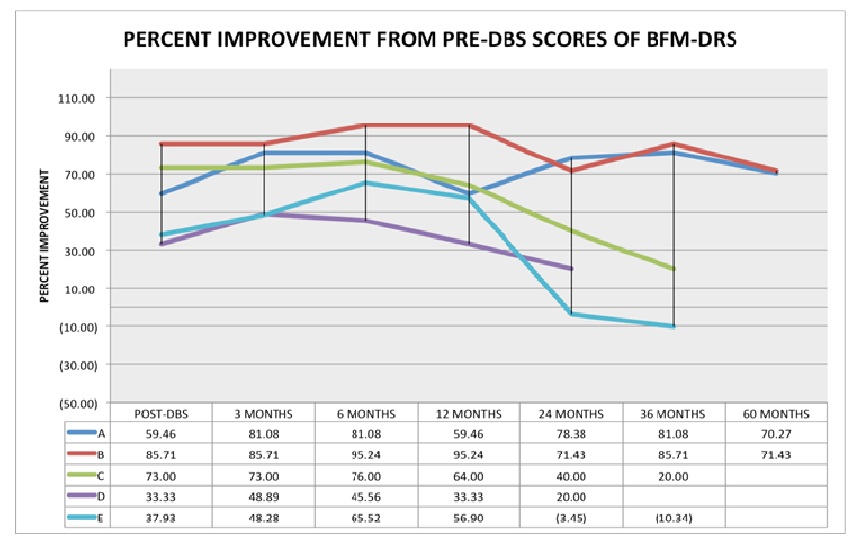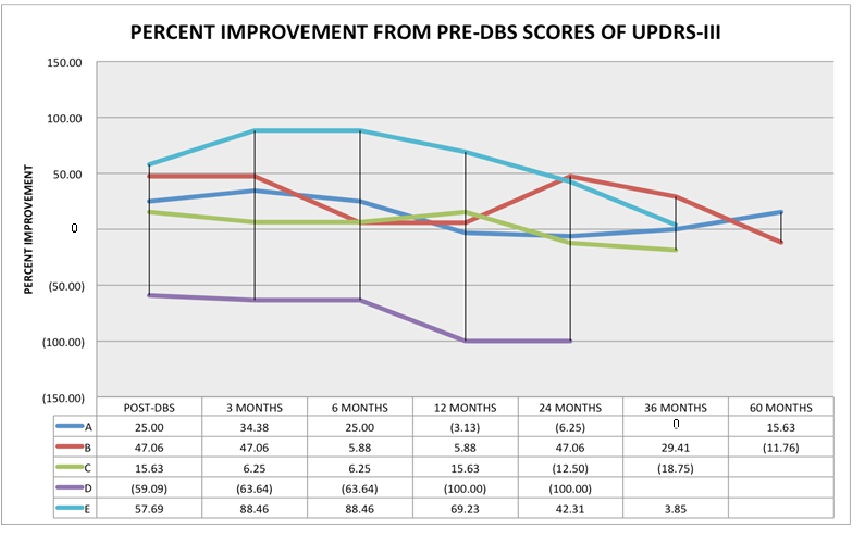Session Information
Date: Monday, June 5, 2017
Session Title: Surgical Therapy: Other Movement Disorders
Session Time: 1:45pm-3:15pm
Location: Exhibit Hall C
Objective: This case series presented the treatment outcomes of the eight (8) XDP patients who underwent DBS in a tertiary hospital and compared it to previous cases reported in literature. It described the percent improvement of their Burke-Fahn Marsden Dystonia Rating Scale and UPDRS-III scores from baseline over time with a longest follow-up of 60 months.
Background: X-linked dystonia-parkinsonism (XDP; DYT3; Lubag Disease) is a progressive hereditary neurodegenerative disease primarily affecting Filipino adult men. It has shown that surgical management in the form of bilateral globus pallidus interna (GPi) deep brain stimulation improves dystonia and has less adverse effects in single case reports.
Methods: This is a case series wherein eight (8) cases of diagnosed X-linked Dystonia Parkinsonism patients that underwent Deep-Brain Stimulation Surgery since 2009 to 2016 in a tertiary hospital were reviewed. The data from patients and similar cases reported in the literature were then tabulated to summarize it. A graph of the percent improvement of their BFMDRS and UPDRS-III motor scores for the patients over time was done, with its longest follow-up of 60 months.
Results: There were eight (8) cases of diagnosed X-linked dystonia parkinsonism (XDP) patients that underwent deep brain stimulation (DBS) surgery in a tertiary hospital from 2009 to 2016. The median duration of the disease prior to surgery was 4.5 years (range 1-9 years). There was an immediate response to treatment in 7 cases with the highest percentage improvement of the BFMDRS score of 85.71% and UPDRS-III score of 66.67% compared from baseline. After 12 months, it has shown that the response over time were variable in terms of controlling dystonia while there was a trend towards worsening of parkinsonism. The peri-operative adverse events were reported but it had no significant post-operative morbidity.
Conclusions: Bilateral GPi deep brain stimulation may be considered as a treatment option for X-linked dystonia parkinsonism. It had shown to be effective in the first 12 months in controlling dystonia with variable resoponse in controlling parkinsonism. Its long-term benefit was not clearly seen in this series probably due to the progessive degenerative nature of the disease and other confounding factors.
To cite this abstract in AMA style:
J.E. Abejero, J. Aguilar, T. Vesagas, R. Teleg, J. Anlacan, R.D. Jamora. Treatment Outcomes for Deep Brain Stimulation in Sex-Linked Dystonia Parkinsonism (XDP, DYT3) Up To 60 Months Follow-up – A Case Series [abstract]. Mov Disord. 2017; 32 (suppl 2). https://www.mdsabstracts.org/abstract/treatment-outcomes-for-deep-brain-stimulation-in-sex-linked-dystonia-parkinsonism-xdp-dyt3-up-to-60-months-follow-up-a-case-series/. Accessed January 7, 2026.« Back to 2017 International Congress
MDS Abstracts - https://www.mdsabstracts.org/abstract/treatment-outcomes-for-deep-brain-stimulation-in-sex-linked-dystonia-parkinsonism-xdp-dyt3-up-to-60-months-follow-up-a-case-series/


